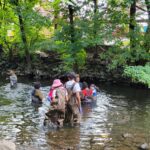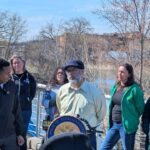Shoelace Park is a part of the Bronx River Greenway that runs from E Gun Hill Road to E230th street. The park is home to a boat launch, playgrounds, running and biking trails, a public bathroom, and beautiful views of the Bronx River.
The park also has a very unique and significant history. The roadbed of the main pathway in the park is the site of a portion of the original Bronx River Parkway. The Bronx River Parkway was completed in 1925 and was seen as both a site for leisure driving and a critical connection from the city to the country. However, shortly after the parkway was completed, its design became obsolete due to advances in automobile technology that made cars too fast for the narrow and curved road. In 1950 the portion of the parkway that is now Shoelace park was relocated from Bronx Boulevard to where it currently stands, adjacent to the Bronx River. The original roadbed remained in place and serves as the upper path in the park.
.png)
Bronx Boulevard/Bronx River Parkway and E213th Street in 1937 (NYPL)
While it is historical, the roadbed is not ideal for use by park goers. In November 2019 construction started to reconstruct the roadbed into a multi use trail using design standards to increase cyclist and pedestrian safety. The new project includes new wayfinding signage, park amenities such as picnic tables and seating areas, and important drainage systems and green infrastructure. The project is part of a larger reenvisioning and renovation of Shoelace Park, outlined in the Shoelace Park Master Plan, a guiding document produced in 2010 by the Bronx River Alliance and NYC Parks working closely with local communities. To view the master plan click here
.png)
Left: Shoelace Park current conditions; Right: rendering of roadbed rennovations once completed
During the course of construction certain parts of the pathway will be closed, but north-south access will be maintained by the lower path in the park. To follow progress of the project and to check for closures, click here
Construction is expected to be completed by April 2021 but may be delayed because of the COVID 19 non-essential construction stop work order.




